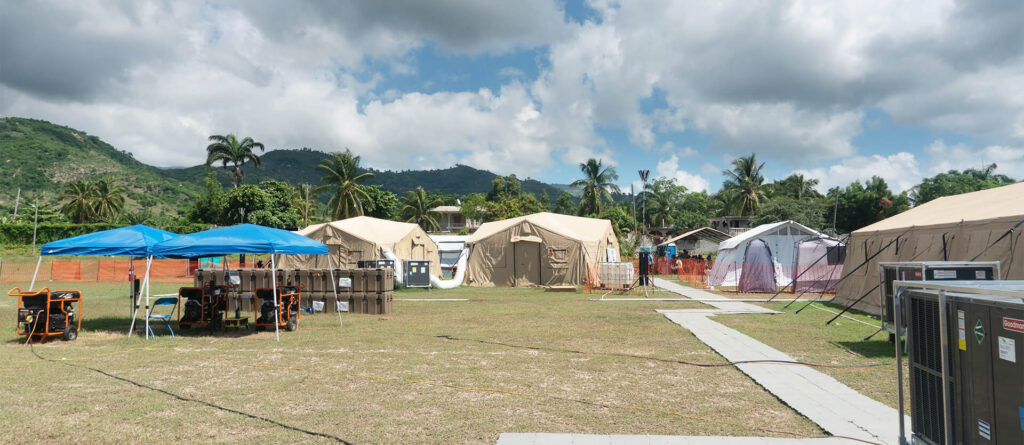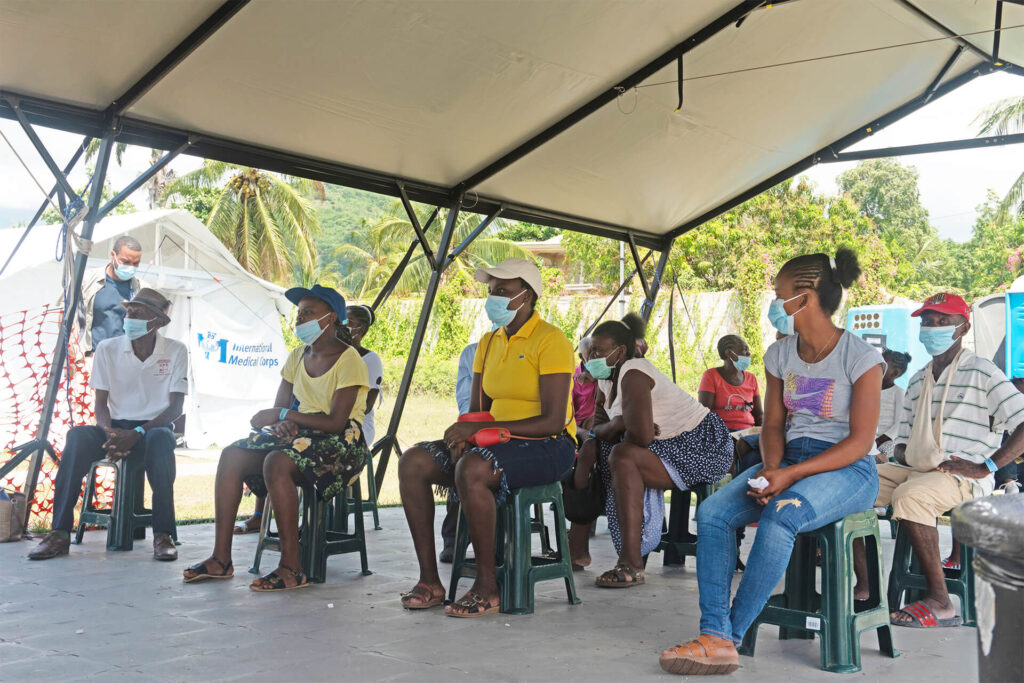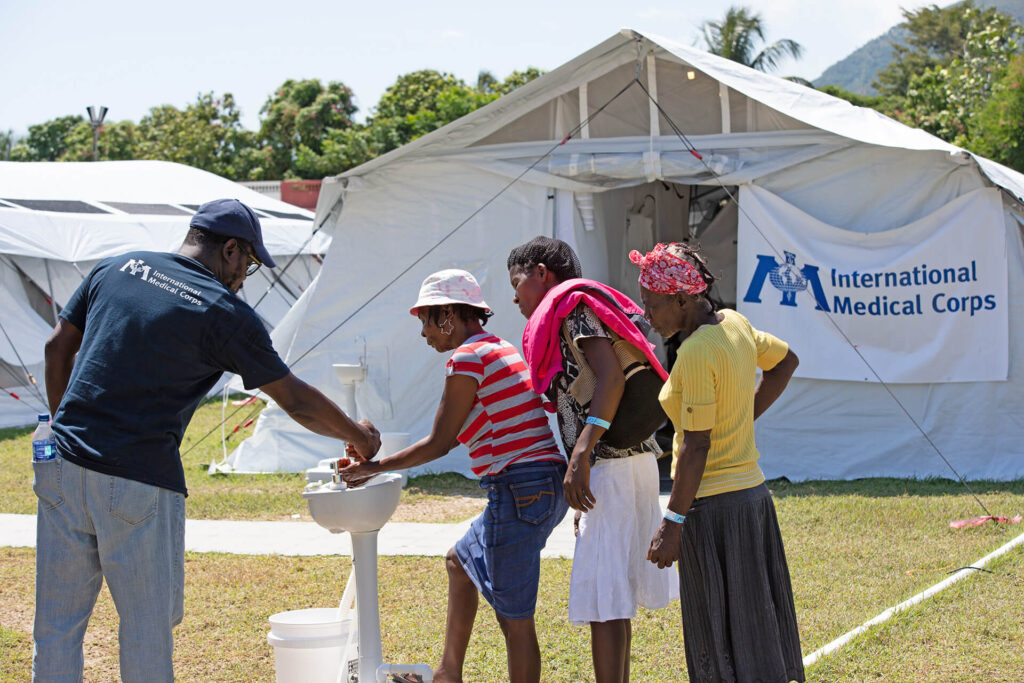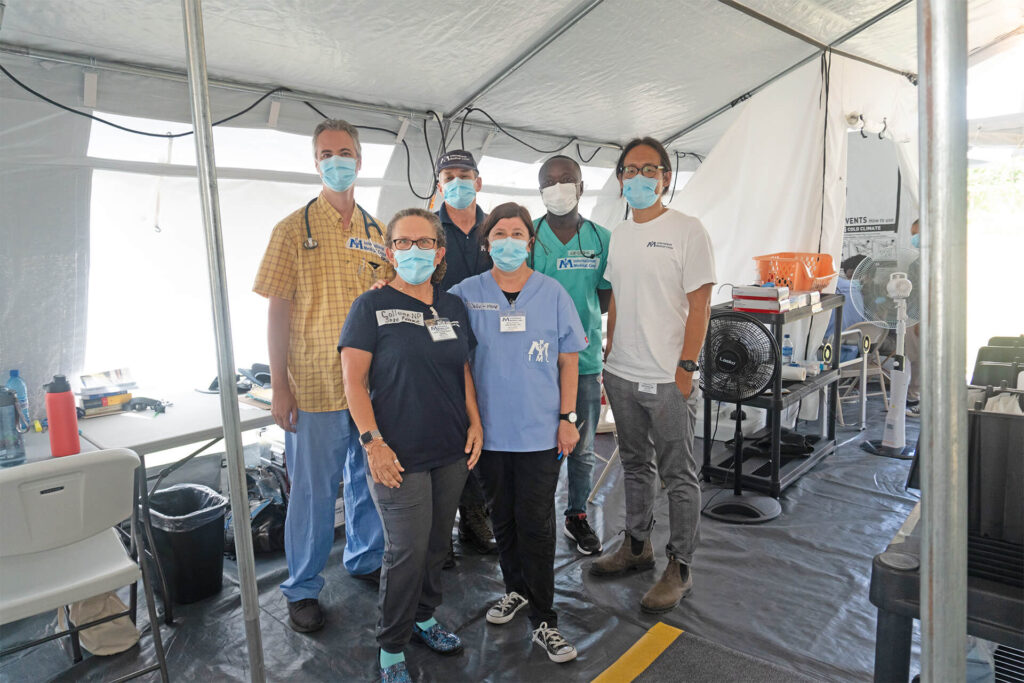When a massive earthquake rocked Haiti on August 14, more than 650,000 people were left in need of emergency humanitarian assistance, while more than half of healthcare facilities were damaged or destroyed. At the request of the Haitian government, International Medical Corps staff and volunteers deployed our Emergency Medical Team (EMT) Fixed Type 1 facility—a multi-tent field hospital, accompanied by a team of clinical and emergency response experts—to Aquin, on Haiti’s southwest coast, in early September. This is the story of how a team of medical volunteers worked with two local nurses, our security and logistics teams, and one local hospital to save a 16-day-old baby.
The United Nations Population Fund (UNFPA) estimates that 22,000 women in Haiti will give birth in the next three months. Thanks to the earthquake and the damage it caused to healthcare infrastructure in the country, thousands of women have already gone without prenatal and post-natal care and given birth at home without a trained medical professional. Such was the case for a woman who came to our field hospital in mid-September with an extremely malnourished infant.
“The first thing I noticed was that the baby was jaundiced from head to toe,” says Colleen Donovan-Batson, a nurse practitioner and midwife from Washington state who was on her first volunteer medical mission with International Medical Corps. “I asked Erin Riley, another volunteer nurse, to help evaluate him.”
The baby had a normal temperature, but he was severely underweight, at around 3.5 pounds. His mother explained that he wasn’t eating and was becoming less responsive.
“We tried to get the baby to nurse from his mother’s breast, but it was clear he had no energy to suck,” explains Colleen. “And then he moved from having an abnormally high respiratory rate to a very low respiratory rate. The normal rate for a newborn is 40 to 60 breaths per minute. Initially, his breathing rate was over 80, and then it dropped down to 20. That’s when we knew that his life was in danger.”
They called Dr. Robert Fuller, chief of service in the University of Connecticut Health Emergency Department and longtime International Medical Corps volunteer, who was leading the team as the medical coordinator, and requested transport to a hospital with a newborn intensive care unit (NICU).
Colleen gave the baby ibuprofen and antibiotics to help relieve pain and battle any potential infections, but the team needed to hydrate him quickly, which proved difficult.

“With malnourished newborns like this who are very dehydrated, we can easily cause them to have congestive heart failure by giving IV fluids,” explains Dr. Kirk Scirto, a physician from Buffalo, New York, who was volunteering in Haiti with the team. “Colleen encouraged feeding by mouth, but this exhausted baby wasn’t taking much in at all. We needed to get IV fluids into him, but conventional methods weren’t an option for us.”
At this point, his respiration rate had dropped so dramatically that Colleen was “breathing for him,” placing a mask with a bag attached to it over his nose and mouth, and hand-pumping air into his lungs. She alternated with Erin Riley, a registered nurse also on her first deployment with International Medical Corps.
Meanwhile, Rob was contacting local hospitals to see which ones had an operational NICU and the resources necessary to care for a critical newborn.
“When assessing an emergency situation in a low-resource environment,” Rob explains, “you do it on three levels: the resources available in the field hospital, the resources available in local hospitals and resources available for the family. In this case, we didn’t have specialized NICU equipment available in the field hospital. We needed to find a local hospital that did and that could accept a new patient—and the care needed to be free of charge, since the family was not able to pay.”
Eventually, he got in touch with Dr. Moise Compere, medical director of Saint Boniface Hospital—which is supported by Health Equity International, and free for all patients—who agreed to take the infant. However, the infant still wasn’t hydrated or stable to travel, and the team knew it would take more than an hour-and-a-half to drive to the hospital.
“After much debate and failed attempts at other methods, we decided to try going through his shin bone to provide hydration,” explains Dr. Alex Wang, an attending physician in emergency medicine at Mayo Clinic Health System. “In a hospital back home, we’d use a drill to stabilize the needle, and it would go in easily. However, we didn’t have a drill, so I had to manually insert the needle into the baby’s left shin. Rob found a small plastic bottle—about the size of a tube of lipstick—cut it in half, and taped it around the baby’s shin to keep the needle in place while we hydrated him.”
Meanwhile, an International Medical Corps mental health counselor met with the baby’s mother and helped keep her calm her during this overwhelming, traumatic situation.
“We also had two local nurse trainees—Samedi and Vales—in our tent at the time,” adds Erin. “They were incredibly helpful, jumping in and getting us supplies as we needed them. I think they learned a lot from the scenario. And Julie Brestle, another volunteer nurse with International Medical Corps, was able to get us supplies and translate for the local nurses what was happening.”
Once the baby was hydrated, the team was ready to transport him to the hospital. However, the next challenge emerged: the International Medical Corps vehicle was out of fuel, and local gangs had a reputation for ambushing large vehicles along the road to the gas station.

Our logistics team sprang into action, with one team member grabbing an empty jerry can and hopping on a motorcycle. He waited in line at the nearest gas station and returned with enough fuel for the vehicle to make the trip to Saint Boniface Hospital and back. Meanwhile, our security team worked to identify the safest route to the hospital.
To transport the infant, Rob grabbed a shelf from another tent in the field hospital and used it as a “baby stretcher.” They placed the baby on it and put the stretcher between the driver and passenger seats in the front to stabilize it.
Then the driver, Rob, Alex, the baby’s mother and Geraldine Superville, a volunteer nurse practitioner who speaks Creole and translated for the mother, got in and drove away. The mother’s mother—the baby’s grandmother—followed the team in her car.
After nearly two hours on the road, they arrived at the hospital.
“I was very impressed by the professionalism of the Saint Boniface Hospital staff and facility,” Rob explains. “You don’t know what to expect when you pull up to a hospital you’ve never seen before. You wonder if the quality of care will be better than what you could have offered in the field hospital. But the team there was fantastic.
“First of all, they wouldn’t let us in, which is completely appropriate—we were muddy and unsanitary. The staff was wearing personal protective equipment and gently took the infant into their care. They removed his dirty clothes and placed him on a scale to get his initial weight, because it’s critical to weigh babies his age from moment to moment. Then they put him in a sterile bassinet and wheeled him out of view. They also attended to the mother right away and got her registered.”
The International Medical Corps team left, cautiously optimistic that things would work out. “Two days later, I received a call from Dr. Compere,” Rob remembers. “Both baby and mother were doing well.”
The rescue was an incredible effort and involved staff from throughout the EMT.
“Everyone on our team—from logistics, to the drivers, to the medical team, to our national staff—all played an important role, and we all communicated well,” says Erin. “Had that not been the case, I think this would have been a completely different story.”
The EMT is still providing care in Haiti, with staff and volunteers seeing approximately 80 to 100 patients per day. True to International Medical Corps’ mission of strengthening local healthcare systems and communities through training and capacity-building, we have been hiring local staff in a number of clinical and other roles, and now operate with Haitians in approximately 75% of EMT positions.

